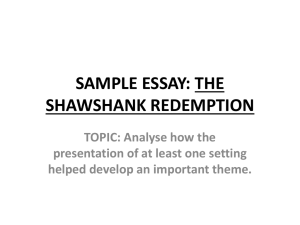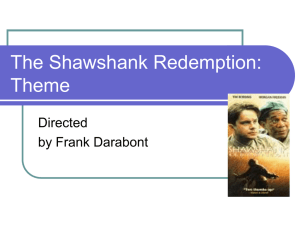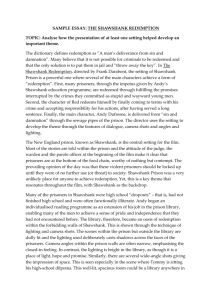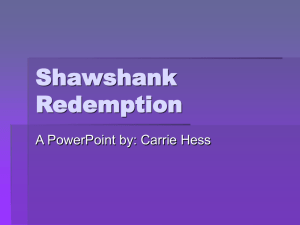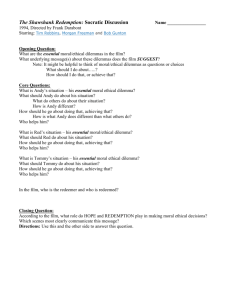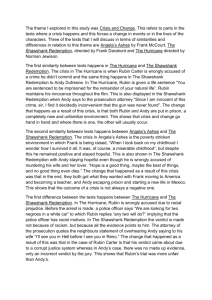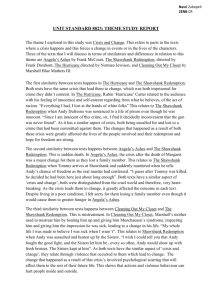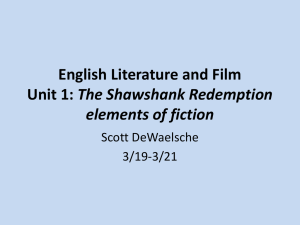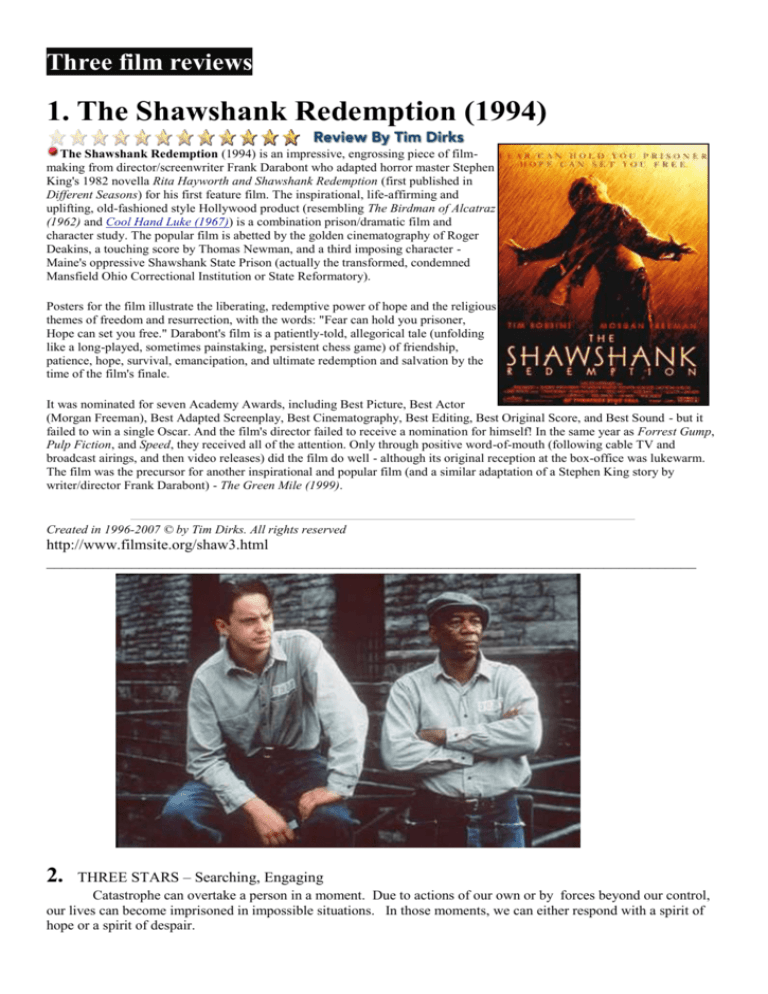
Three film reviews
1. The Shawshank Redemption (1994)
The Shawshank Redemption (1994) is an impressive, engrossing piece of filmmaking from director/screenwriter Frank Darabont who adapted horror master Stephen
King's 1982 novella Rita Hayworth and Shawshank Redemption (first published in
Different Seasons) for his first feature film. The inspirational, life-affirming and
uplifting, old-fashioned style Hollywood product (resembling The Birdman of Alcatraz
(1962) and Cool Hand Luke (1967)) is a combination prison/dramatic film and
character study. The popular film is abetted by the golden cinematography of Roger
Deakins, a touching score by Thomas Newman, and a third imposing character Maine's oppressive Shawshank State Prison (actually the transformed, condemned
Mansfield Ohio Correctional Institution or State Reformatory).
Posters for the film illustrate the liberating, redemptive power of hope and the religious
themes of freedom and resurrection, with the words: "Fear can hold you prisoner,
Hope can set you free." Darabont's film is a patiently-told, allegorical tale (unfolding
like a long-played, sometimes painstaking, persistent chess game) of friendship,
patience, hope, survival, emancipation, and ultimate redemption and salvation by the
time of the film's finale.
It was nominated for seven Academy Awards, including Best Picture, Best Actor
(Morgan Freeman), Best Adapted Screenplay, Best Cinematography, Best Editing, Best Original Score, and Best Sound - but it
failed to win a single Oscar. And the film's director failed to receive a nomination for himself! In the same year as Forrest Gump,
Pulp Fiction, and Speed, they received all of the attention. Only through positive word-of-mouth (following cable TV and
broadcast airings, and then video releases) did the film do well - although its original reception at the box-office was lukewarm.
The film was the precursor for another inspirational and popular film (and a similar adaptation of a Stephen King story by
writer/director Frank Darabont) - The Green Mile (1999).
Created in 1996-2007 © by Tim Dirks. All rights reserved
http://www.filmsite.org/shaw3.html
____________________________________________________________________________________
2.
THREE STARS – Searching, Engaging
Catastrophe can overtake a person in a moment. Due to actions of our own or by forces beyond our control,
our lives can become imprisoned in impossible situations. In those moments, we can either respond with a spirit of
hope or a spirit of despair.
Andy Dufresne (Tim Robbins) experiences this reality when he is sentenced to two consecutive life sentences
in Shawshank Prison, though he is innocent of any crime. “Shawshank Redemption” is the story of his hope which
fuels his survival.
There is no more oppressive visual representation of despair than the walls of Shawshank. As the camera
pans their grotesque shapes they have an almost mystical quality to them.
Red (Morgan Freeman) describes the enslaving experience of being within those walls: “The walls begin as
something you hate. As the years go by you get used to them, until finally you depend on them.”
This truth that tragedy can become a way of life, and despair a trusted friend, is a deeply spiritual and social
message. In many ways our society as a whole has given up hope and come to depend on walls to protect and insulate
us. This is exemplified in part by the fact that in California over the last 20 years, we have not built one new
university, yet we have built 18 new prisons. Seeming to have given up hope in educating our populace, we are
committed instead to providing for their incarceration.
But where does this lead? If the walls of enslavement become our trusted friends, then will we become
unable to live free of their custody? The film answers this question in the life of an old prisoner, Brooks (James
Whitmore), when he is released after 50 years in Shawshank. Unable to dream or create a connection of friendship or
find meaning to his life, Brooks commits suicide. This ultimate act of despair demonstrates the reality of his spiritual
void.
In clear opposition to this despair is Andy’s unrelenting hope.
A closed and private person, Andy exemplifies a strength that, though misunderstood and isolating, is
nevertheless admired. When told that “Hope is a dangerous thing,” he responds, “Hope is a good thing, maybe the
best of things, and no good thing ever dies.” This transcendent value of trusting the future and having hope in it
mentally and emotionally is the strength within this private man.
What we as the viewers and the other prisoners don’t know is that for twenty years, and through ingenious
planning and unusual opportunities, Andy is feeding his hope with concrete actions to escape. Perhaps it is this
combination of spirit and action which makes Andy’s hope so vibrant. When he shares his dream of the future, he is
accused by Red of having a pipe dream, a useless wish that only makes his enslavement more painful.
But we eventually discover that his dream is not without feet and his hope is not without action. Andy’s hope
is real and finally realized. In becoming free, Andy also becomes involved in setting things right at Shawshank.
Shawshank is under the control of a hypocritical warden who spouts Bible verses while allowing his prisoners
to be brutally beaten, demeaned and murdered. Though the warden serves as a villain, the film’s caricatured Christian
typecast weakens its message. Aside from the warden’s actions, the prison, in and of itself, with it’s walls, its
violence, it’s dehumanizing routine and its inability to rehabilitate is also in need of redemption.
“Shawshank Redemption” is an engaging film which begins to unwrap the component parts of hope. The
inward strength, the outward action and giving hope to others were all demonstrated by Andy. If the film had given
us insight into the source of hope and the spiritual basis for Andy’s faith, it would have been even more powerful.
http://www.cinemainfocus.com/Shawshank%20Redemption_3.htm
"The Heart Cannot Be Held Captive..."
Directed by Frank Darabont - Written by Frank Darabont
Starring Tim Robbins, Morgan Freeman, James Whitmore, William Sadler
Distributed by Columbia - 1994 - 142m - Rated R
3. Review by Michael Jacobson
The Shawshank Redemption was one of the best films of the 90’s, and
thankfully, seems to have garnered more attention and appreciation as time has gone by. It had the
misfortune of quietly coming to theatres in 1994, where it was largely overshadowed by two other popular
and critical favourites, Forrest Gump and Pulp Fiction. Despite being honoured with seven Oscar
nominations that year, it came up empty. But that’s of little matter.
What does matter is that novelist Stephen King and screenwriter/director Frank Darabont created a
thoughtful, strangely beautiful, and strikingly honest character study of two men serving life sentences in
the fictional prison of Shawshank in Maine. The wonderful script and impeccable direction are brought to
visual life by two masterful performances in Tim Robbins and Morgan Freeman.
One of the unique approaches of the film is to open the audience’s minds almost immediately. When the
film begins, we witness glimpses of Andy’s (Robbins) trial for murdering his wife and her lover. We hear
the evidence in court. We see a few flashbacks to the night of the crime. Andy maintains his innocence, but
the viewers simply don’t know whether or not he really did it—and that fact is not made abundantly clear
until closer to the end of the picture. So when Andy is sentenced to life, we have no way of knowing if it’s
justified or not. We aren’t immediately drawn into rooting for the falsely accused underdog, nor are we
ready to dismiss Andy’s confinement as being justice for a killer. We have no choice but to watch Andy
closely, and what happens to him, and for a marked period of time, witness what happens to him without
judgment.
In Shawshank, Andy becomes friends with another “lifer”, Red (Freeman). Unlike Andy, Red makes it
clear that he is in fact guilty of murder, although the details of his crime are left sketchy at best…another
good choice for Darabont. Andy may be the principal character here, but his story is told through Red’s
eyes, and thanks to the script and Freeman’s winning work, it doesn’t take long to warm up to Red’s
character.
As these two men share a 19 year incarceration, the film explores prison life fully. We see the horrors of
cruel guards, uncaring wardens, and the abuse that can occur at the hands of other inmates. But with Andy’s
mind and spirit, we also see the less bleak moments, such as when Andy manages to create a functional
library for the prison, or how he helps young wayward fellows to try for and pass their high school
equivalence exam.
The passage of time is an important theme, and the way Darabont presents it is fascinating. Nothing much
changes inside the walls of the prison. We observe the slight aging effects on both Andy and Red, how they
get a little slower and a little more weary as the years pass. However, two times we get glimpses of the
outside world through the eyes of former inmates. One in particular, and old man named Brooks, remarks
in a letter to his friends how fast the world had gotten since his incarceration. And one can’t help but think
of the word “rehabilitate”, and how much it comes up in the movie. On the surface, the word can simply
mean that the prisoner has mended his ways, and learned his lesson, so to speak. But on another level, it
means a readiness to rejoin society. It’s the part of the equation that’s sadly lacking, as those who have
spent decades behind bars have no clue as to what awaits them on the outside…and little or no chance of
ever fitting in again.
Red remarks about the prison walls at one point: “First you hate them, then you get used to them. Then,
after a while, you get to where you depend on them.” He suggests, and the movie corroborates, that after
enough time has passed behind bars, there’s nothing much left for a man on the outside world.
The movie, despite a bleak subject matter and often harsh realizations, manages to maintain a true sense of
the human spirit’s ability to triumph. Andy remarks to Red, “You have two choices. Get busy living, or get
busy dying.” Their world has little promise, but Andy’s ability to shine like a lamp in the darkness…no
matter how faintly…has a positive effect on those around him. And even a hardened timer like Red finds
that there can be more to prison life than simply rotting away and waiting to die.
It is this spirit that has continued to win The Shawshank Redemption new fans, as well as repeat viewings
from those who loved it the first time around. It’s simply a well-made, written, and acted character drama
that proves that the heart, the mind, and the soul can never be locked away.
http://www.dvdmoviecentral.com/ReviewsText/shawshank_redemption.htm

